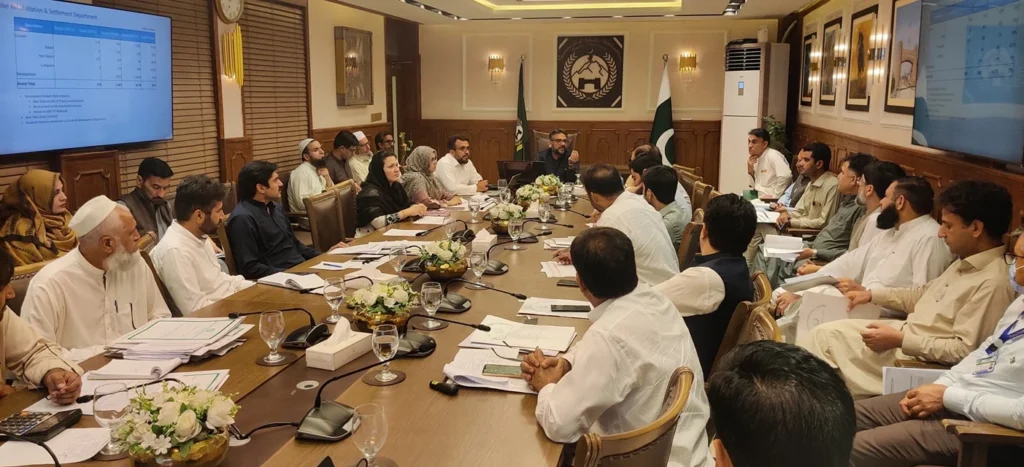The Khyber Pakhtunkhwa (KP) government, under the leadership of the Pakistan Tehreek-e-Insaf (PTI) and the Gandapur Cabinet, has demonstrated remarkable progress in its (KPK) financial management (report) during the fiscal year 2024-25.
With a focus on transparency, efficiency, and fiscal discipline, the province has achieved significant milestones, setting a strong foundation for sustainable development and public welfare.

Financial Discipline and Surplus Achievements:
Despite challenges such as reduced federal funding for developmental projects, non-payment of AIP, and lower FBR collections, the KP government has set an ambitious target of achieving a Rs. 100 billion budget surplus for the fiscal year 2025.
- Rs. 169 Billion Surplus in Six Months: The province exceeded expectations by securing a Rs. 169 billion surplus in just six months, surpassing the Rs. 69 billion target.
- 46% Increase in Tax Revenue: KP witnessed a 46% rise in tax revenue, reflecting improved tax collection mechanisms.
- 55% Growth in Non-Tax Revenue: Non-tax revenue also saw a significant 55% increase, showcasing the government’s efforts to diversify income streams.
- 50% Overall Revenue Growth: KP outperformed other provinces by achieving a 50% increase in total revenue, highlighting its financial resilience.
Addressing Past Administrative Challenges:
The KP government has taken proactive steps to resolve long-standing administrative and financial issues, ensuring a clean slate for future development.
- Rs. 70 Billion for Debt Retirement Fund: For the first time, Rs. 70 billion was allocated for a Debt Retirement Fund, with Rs. 30 billion already deposited.
- No Liabilities Left Behind: Unlike previous administrations, the current government cleared all pending liabilities, including Rs. 78.6 billion owed to TMAs, WSSCs, and universities.
- Timely Payments: Salaries, pensions, and health card payments were made on time, with salaries disbursed before the first of every month.
- Improved Cash Reserves: The government maintained a cash balance equivalent to three months’ salaries in Account-1, a significant improvement compared to the previous administration’s one-month reserve.
New Revenue Initiatives:
To boost income, the KP government introduced over 50 revenue-generating measures, resulting in a 14 billion rupee increase in revenue.
- 200% Increase in Mineral Royalties: Mineral royalties were doubled, expected to generate substantial income for the province.
- Infrastructure Development Cess: A new cess on exports and Afghan transit trade is projected to bring in an additional Rs. 10 billion.
- Provincial Revenue Target: For the first time, KP set a Rs. 100 billion target for its own revenue, demonstrating financial independence.
- 35% Increase in Development Funds: Development funds were increased by 35%, with Rs. 78 billion allocated for various projects.
Focus on Public Welfare:
The KP government prioritized public welfare by allocating significant funds to health, education, and social programs.
- 36% Budget for Health and Education: Exceeding IMF standards, 36% of the budget was dedicated to health and education.
- Rs. 30.4 Billion for Health Card: The Sehat Card Plus program benefited 789,721 patients, ensuring access to quality healthcare.
- Direct Wheat Procurement: Rs. 20 billion was allocated for direct wheat procurement to address food security challenges.
- Ehsaas Program: Rs. 15 billion was earmarked for skill development, social welfare, women and youth empowerment, and affordable housing initiatives.
Improved Local Tax Collection:
The KP government implemented several measures to enhance local tax collection, ensuring a steady revenue stream.
- Expansion of Services Tax: Services tax was extended to include waste management, healthcare, insurance, and passenger transport.
- Increase in Property and Agricultural Taxes: Property and agricultural land tax rates were revised to boost revenue.
- Higher Penalties and Fines: Penalties and fines for non-compliance were increased to encourage timely payments.
- Efficient Tax Rates: Property transfer taxes were optimized to promote documentation and transparency.
Conclusion:
The Khyber Pakhtunkhwa government’s one-year performance (KPK Financial Management Report) in fiscal management has set a new benchmark for governance in Pakistan.
By achieving a budget surplus, clearing past liabilities, and introducing innovative revenue measures, the province has laid a strong foundation for sustainable development.
With a focus on public welfare, transparency, and financial discipline, KP is on track to become a model province for others to follow.
This remarkable progress not only ensures economic stability but also promises a brighter future for the people of Khyber Pakhtunkhwa.
You Can Read More: White Paper for 2024-25

